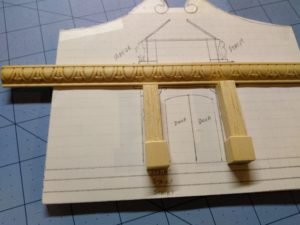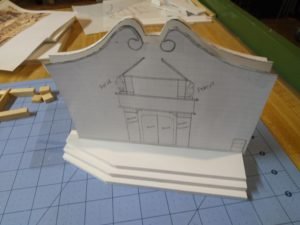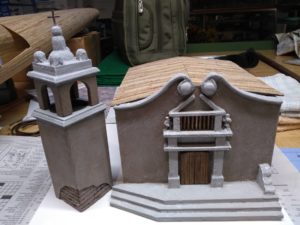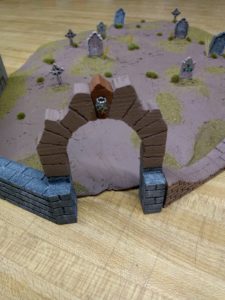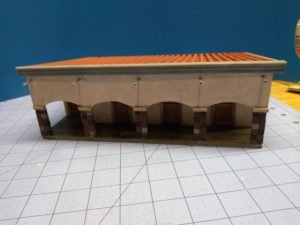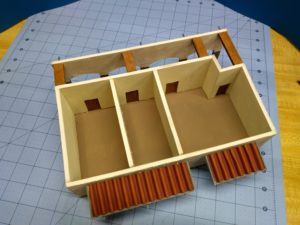This issue’s crafty gamer is my father-in-law, Greg Principato, Sr.! He’s seen it all in the miniature wargames world from playing, running games, operating a miniatures supply shop, helping with conventions (organization, running games), building his own terrain sets, modifying rules to work for his own games, and more. Today he’s sharing his current project: full terrain for a Magnificent 7 game.
To Play Is Human: How did you get started with tabletop game and accessories crafting?
Greg Principato, Sr.: When I was about 12 my brothers and I had a HO train and a western town. We would set this up on a table in our basement using Airfix cowboys and Indians to populate the town and they also provided our antagonists and protagonists. Since westerns abounded on TV at that time we were able to re-create any number of conflicts to game. Our middle brother, Rick, was into plastic models and was very good at building and painting them. Our mother was a very craft oriented person also so I had a couple of people to inspire my creative juices. So armed with these influences I decided to start making scenery and accessories for our town and the countryside around it. Glue, popcicle sticks and paper became my friends and they still are.
TPIH: Tell me a bit about the Magnificent 7 tabletop set that you made. How did the project come about, what was the process, what kinds of tools/supplies did you use?
Greg: The Magnificent Seven has always been one of my favorite movies. Based on the famous Japanese movie, The Seven Samurai, it has shows good life lessons in spite of poor decisions, oppression and conflict. For many years I had dreamed of playing a game based on favorite movies and my recent retirement allowed me to pursue this particular dream. First I spent many hours watching the movie on DVD and clips on YouTube over and over noting details about each building and then details about the area around the village. I would make a sketch of each building to scale using graph paper prior to beginning construction.
Each building began by cutting and assembling the exterior walls and the floor. Cutouts for the doors and windows were made at this point as well as adding a floor. These areas would then be painted and textured with any interior details added. Next the roof would be created using either the bamboo wallpaper or corrugated cardboard depending on the type of roof desired.
All walls and floors were glued together using hot glue. Trim and doors are added as needed. The material used for construction is foam core. This is like poster board with a layer of foam sandwiched between two layers of card board. With this I can make a sturdy structure but is very light in weight. Also used was bass wood, Spackle, paper, craft paint, wallpaper, corrugated cardboard, and various bits and pieces from the craft stores like a bell, cross, and various shapes of wood. Tools I used for this project were a razor knife, hot glue gun, white glue, metal ruler, a square, cutting board and my computer. The above list is for the buildings.
The hills and rocks were made from construction foam, wood putty, cat litter (clean) and pine bark. Tools for them were a hot glue gun, palette knife and craft paint.
The photos below show the final layout of the town:
TPIH: What does your work space look like and what tools do you always have nearby?
Greg: I am fortunate in having a very large work area. I use my gaming table for cutting, painting, layout and assembly. This area is 5’ x 12’. This much space is not needed for this work but since I have it I try to take advantage of the time it saves me. Tools that are always at hand are hobby knives, paint brushes, water, palette, paints and glue.
TPIH: What do you enjoy about tabletop crafting?
Greg: Table top crafting provides me with an outlet for my imagination. By taking something and turning it into an entirely different object is very satisfying. In a small way I feel like an artist. Having others appreciate the time and effort adds to that satisfaction. In addition to the artistic angle it also allows me to create scenery and detail for my tabletop games.
TPIH: What are some other games that you would like to create custom components for in the future?
Greg: I believe my next project will be to recreate, for a game, the scene from Aliens where the Marines battle the Aliens for the first time near the reactor. I have the characters ready to go, for years actually, but the surroundings will be a bit of a challenge. In addition to making it look identifiable it will need to be designed for playability by the gamers.
TPIH: What advice would you give to someone thinking about getting into tabletop crafting?
Greg: For anyone looking to begin table top crafting I would suggest that you look at our world with a fresh and open mind. This may take some practice as we are as a group used to accepting things at face value. Expand on what you see, imagine how something that is used for one thing could be used as something completely different. Think back to when you were in school with paper, scissors, crayons and glue only now you can use sharp knives and sophisticated materials!
TPIH: Where do you go to find information on tabletop crafting?
Greg: YouTube is a fantastic resource. You can not only find many fantastic ideas but skilled people will take you step-by-step through the details to recreate what you have searched for. Also there are numerous books in the library explaining ways to craft items. Plastic models, wood working, painting, molding, sculpting and all of the materials needed to work with them. When I was young we did not have the luxury of the internet so most of our research was in the library or interacting with others who would hang out at the hobby store. So talk to people who have worked with the craft you are interested in. It is amazing how the creativity flows from interactions like these.
TPIH: What is your favorite game?
Greg: While I use many games/rules my go to set is ‘The Sword and the Flame’. These rules were written for miniature battles during Queen Victoria’s reign. Very flexible over a number of eras, scales, and miniatures. These were published 1978 and written by Larry Brom. I have seen these rules, with modifications, used for games all historical periods and some fantasy as well.
TPIH: Thanks for sharing this project with us, Greg!
Readers, if you’d like to see Greg’s other projects, you can find them on his blog!
CALL FOR SUBMISSIONS
Do you have a tabletop gaming project that you’ve created? Contact me with some information and photos. No project is too big/small — as long as you made it yourself and you use it when you game, it is eligible for submission! I would love to see projects for board game upgrades and accessories, RPGs, miniatures (I would love to see mini paint jobs!), terrain, dice towers, custom playmats, custom dice, or anything else you have made.






